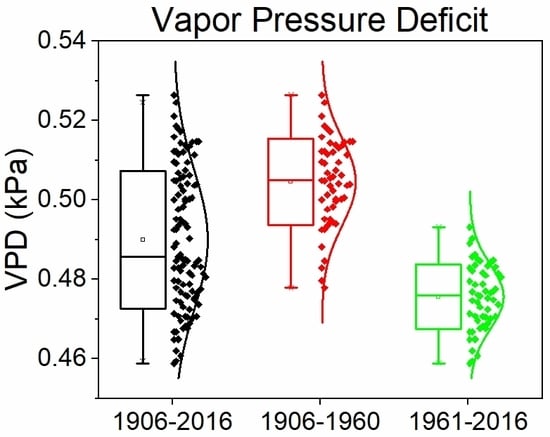Changing Climatic Averages and Variance: Implications for Mesophication at the Eastern Edge of North America’s Eastern Deciduous Forest
Abstract
1. Introduction
1.1. Eastern Deciduous Forest’s Changing Climate
1.2. West Virginia’s Changing Forest Ecosystem
2. Materials and Methods
3. Results and Discussion
4. Summary
5. Conclusions
Supplementary Materials
Author Contributions
Funding
Acknowledgments
Conflicts of Interest
References
- Vose, R.S.; Easterling, D.R.; Kunkel, K.E.; LeGrande, A.N.; Wehner, M.F. Temperature changes in the United States. Clim. Sci. Spec. Rep. 2017, 1, 185–206. [Google Scholar] [CrossRef]
- Horton, D.E.; Johnson, N.C.; Singh, D.; Swain, D.L.; Rajaratnam, B.; Diffenbaugh, N.S. Contribution of changes in atmospheric circulation patterns to extreme temperature trends. Nature 2015, 522, 465–469. [Google Scholar] [CrossRef] [PubMed]
- Trenberth, K.E. Changes in precipitation with climate change. Clim. Res. 2011, 47, 123–138. [Google Scholar] [CrossRef]
- Greenland, D.; Goodin, D.G.; Smith, R.C. Climate Variability and Ecosystem Response at Long-Term Ecological Research Sites; Oxford University Press: New York, NY, USA, 2003; ISBN 0195150597. [Google Scholar]
- Costanza, R.; de Groot, R.; Sutton, P.; van der Ploeg, S.; Anderson, S.J.; Kubiszewski, I.; Farber, S.; Turner, R.K. Changes in the global value of ecosystem services. Glob. Environ. Chang. 2014, 26, 152–158. [Google Scholar] [CrossRef]
- Millar, C.I.; Stephenson, N.L. Temperate forest health in an era of emerging megadisturbance. Science 2015, 349, 823–826. [Google Scholar] [CrossRef] [PubMed]
- Trumbore, S.; Brando, P.; Hartmann, H. Forest health and global change. Science 2015, 349, 814–818. [Google Scholar] [CrossRef] [PubMed]
- Zell, C.; Hubbart, J.A. Interdisciplinary linkages of biophysical processes and resilience theory: Pursuing predictability. Ecol. Model. 2013, 248, 1–10. [Google Scholar] [CrossRef]
- Bentz, B.J.; Regniere, J.; Fettig, C.J. Climate change and bark beetles of the western United States and Canada: Direct and indirect effects. Bioscience 2010, 60, 602–613. [Google Scholar] [CrossRef]
- Hubbart, J.A.; Guyette, R.; Muzika, R.M. More than drought: Precipitation variance, excessive wetness, pathogens and the future of the western edge of the Eastern Deciduous Forest. Sci. Total Environ. 2016, 566–567, 463–467. [Google Scholar] [CrossRef] [PubMed]
- Augspurger, C.K.; Wilkinson, H.T. Host specificity of pathogenic Pythium species: Implications for tree species diversity. Biotropica 2007, 39, 702–708. [Google Scholar] [CrossRef]
- Reed, S.E.; English, J.T.; Muzika, R.-M.; Kabrick, J.M.; Wright, S. Characteristics of sites and trees affected by rapid white oak mortality. In Proceedings of the 20th Central Hardwood Forest Conference, Columbia, MO, USA, 28 March–1 April 2016. [Google Scholar]
- Reinhart, K.O.; Royo, A.A.; Van Der Putten, W.H.; Clay, K. Soil feedback and pathogen activity in Prunus serotina throughout its native range. J. Ecol. 2005, 93, 890–898. [Google Scholar] [CrossRef]
- Sturrock, R.N.; Frankel, S.J.; Brown, A.V.; Hennon, P.E.; Kliejunas, J.T.; Lewis, K.J.; Worrall, J.J.; Woods, A.J. Climate change and forest diseases. Plant Pathol. 2011, 60, 133–149. [Google Scholar] [CrossRef]
- Anagnostakis, S.L. Chestnut blight: The classical problem of an introduced pathogen. Mycologia 1987, 79, 23. [Google Scholar] [CrossRef]
- Cale, J.A.; Teale, S.A.; Johnston, M.T.; Boyer, G.L.; Perri, K.A.; Castello, J.D. New ecological and physiological dimensions of beech bark disease development in aftermath forests. For. Ecol. Manag. 2015, 336, 99–108. [Google Scholar] [CrossRef]
- Kauffman, B.W.; Clatterbuck, W.K.; Liebhold, A.M.; Coyle, D.R. Gypsy Moth in the Southeastern U.S.: Biology, Ecology, and Forest Management Strategies; U.S. Department of Agriculture, Forest Service, Southern Regional Extension Forestry: Athens, GA, USA, 2017.
- Herms, D.A.; McCullough, D.G. Emerald ash borer invasion of North America: History, biology, ecology, impacts, and management. Annu. Rev. Entomol. 2014, 59, 13–30. [Google Scholar] [CrossRef] [PubMed]
- Kim, J.; Hwang, T.; Schaaf, C.L.; Orwig, D.A.; Boose, E.; Munger, J.W. Increased water yield due to the hemlock woolly adelgid infestation in New England. Geophys. Res. Lett. 2017, 44, 2327–2335. [Google Scholar] [CrossRef]
- Wayne, C. Palmer Meteorological Drought. Available online: https://www.ncdc.noaa.gov/temp-and-precip/drought/docs/palmer.pdf (accessed on 1 August 2018).
- Mcewan, R.W.; Dyer, J.M.; Pederson, N. Multiple interacting ecosystem drivers: Toward an encompassing hypothesis of oak forest dynamics across eastern North America. Ecography 2011, 34, 244–256. [Google Scholar] [CrossRef]
- Cook, B.I.; Miller, R.L.; Seager, R. Amplification of the North American “Dust Bowl” drought through human-induced land degradation. Proc. Natl. Acad. Sci. USA 2009, 106, 4997–5001. [Google Scholar] [CrossRef] [PubMed]
- Cook, E.R.; Seager, R.; Cane, M.A.; Stahle, D.W. North American drought: Reconstructions, causes, and consequences. Earth Sci. Rev. 2007, 81, 93–134. [Google Scholar] [CrossRef]
- Herweijer, C.; Seager, R.; Cook, E.R.; Emile-Greay, J. North American droughts of the last millennium from a gridded network of tree-ring data. J. Clim. 2007, 20, 1353–1376. [Google Scholar] [CrossRef]
- Nowacki, G.J.; Abrams, M.D. Is climate an important driver of post-European vegetation change in the Eastern United States? Glob. Chang. Biol. 2015, 21, 314–334. [Google Scholar] [CrossRef] [PubMed]
- Lewis, R.L. Transforming the Appalachian Countryside Railroads, Deforestation, and Social Change in West Virginia, 1880–1920; The University of North Carolina Press: Chapel Hill, NC, USA, 1998; ISBN 9780807847060. [Google Scholar]
- Redding, J. History of deer population trends and forest cutting on the Allegheny National Forest. In Proceedings of the 10th Central Hardwood Forest Conference, Morgantown, WV, USA, 5–8 March 1995. [Google Scholar]
- Prasad, A.; Iverson, L.; Matthews, S.; Peters, M. A Climate Change Atlas for 134 Forest Tree Species of the Eastern United States (Database); U.S. Department of Agriculture, Forest Service, Northern Research Station: Delaware, OH, USA, 2007.
- Hurst, D.M. Ecological Classification and Gradient Analysis in the Monongahela National Forest; Pennsylvania State University: State College, PA, USA, 1994. [Google Scholar]
- Abrams, M.D.; McCay, D.M. Vegetation-site relationships of witness trees (1780–1856) in the presettlement forests of eastern West Virginia. Can. J. For. Res. 1996, 26, 217–224. [Google Scholar] [CrossRef]
- Rentch, J.S.; Hicks, R.R.J. Changes in presettlement forest composition for five areas in the central hardwood forest, 1784–1990. Nat. Areas J. 2005, 25, 228–238. [Google Scholar]
- Morin, R.S.; Cook, G.W.; Barnett, C.J.; Butler, B.J.; Crocker, S.J.; Hatfield, M.A.; Kurtz, C.M.; Lister, T.W.; Luppold, W.G.; McWilliams, W.H.; et al. West Virginia Forests 2013. Available online: https://www.nrs.fs.fed.us/pubs/52444 (accessed on 30 August 2016).
- Guyette, R.P.; Dey, D.C.; Stambaugh, M.C. Fire and human history of a barren-forest mosaic in southern Indiana. Am. Midl. Nat. 2003, 149, 21–34. [Google Scholar] [CrossRef]
- Denevan, W.M. The pristine myth: The landscape of the Americas in 1492. Ann. Assoc. Am. Geogr. 1992, 82, 369–385. [Google Scholar] [CrossRef]
- Abrams, M.D. The demise of fire and “ mesophication ” of forests in the eastern United States. Bioscience 2008, 58, 123–138. [Google Scholar] [CrossRef]
- Whitney, G.G. Fifty years of change in the arboreal vegetation of Heart’s Content, an old-growth hemlock-white pine-northern hardwood stand. Ecology 1984, 65, 403–408. [Google Scholar] [CrossRef]
- Mladenoff, D.J.; Stearns, F. Eastern hemlock regeneration and deer browsing in the northern Great Lakes region: A re-examination and model simulation. Conserv. Biol. 1993, 7, 889–900. [Google Scholar] [CrossRef]
- Birdsey, R.; Pregitzer, K.; Lucier, A. Forest carbon management in the United States. J. Environ. Qual. 2006, 35, 1461. [Google Scholar] [CrossRef] [PubMed]
- Curtis, P.S.; Hanson, P.J.; Bolstad, P.; Barford, C.; Randolph, J.C.; Schmid, H.P.; Wilson, K.B. Biometric and eddy-covariance based estimates of annual carbon storage in five eastern North American deciduous forests. Agric. For. Meteorol. 2002, 113, 3–19. [Google Scholar] [CrossRef]
- Bones, J. The Forest Resources of West Virginia; U.S. Department of Agriculture, Forest Service, Northeastern Forest Experiment Station: Broomall, PA, USA, 1978.
- Zhang, T.; Niinemets, Ü.; Sheffield, J.; Lichstein, J.W. Shifts in tree functional composition amplify the response of forest biomass to climate. Nature 2018, 556, 99–102. [Google Scholar] [CrossRef] [PubMed]
- Baddour, O.; Kontongomde, H. The Role of Climatological Normals in a Changing Climate. Available online: https://library.wmo.int/doc_num.php?explnum_id=4546 (accessed on 27 September 2018).
- Detto, M.; Wright, S.J.; Calderón, O.; Muller-Landau, H.C. Resource acquisition and reproductive strategies of tropical forest in response to the El Niño-Southern Oscillation. Nat. Commun. 2018, 9, 913. [Google Scholar] [CrossRef] [PubMed]
- Trenberth, K.E.; Branstator, G.W.; Karoly, D.; Kumar, A.; Lau, N.-C.; Ropelewski, C. Progress during TOGA in understanding and modeling global teleconnections associated with tropical sea surface temperatures. J. Geophys. Res. Ocean. 1998, 103, 14291–14324. [Google Scholar] [CrossRef]
- Frank, D.; Reichstein, M.; Bahn, M.; Thonicke, K.; Frank, D.; Mahecha, M.D.; Smith, P.; van der Velde, M.; Vicca, S.; Babst, F.; et al. Effects of climate extremes on the terrestrial carbon cycle: Concepts, processes and potential future impacts. Glob. Chang. Biol. 2015, 21, 2861–2880. [Google Scholar] [CrossRef] [PubMed]
- Kimball, J.S.; Running, S.W.; Nemani, R. An improved method for estimating surface humidity from daily minimum temperature. Agric. For. Meteorol. 1997, 85, 87–98. [Google Scholar] [CrossRef]
- Buck, A.L. New equations for computing vapor pressure and enhancement factor. J. Appl. Meteorol. 1981, 20, 1527–1532. [Google Scholar] [CrossRef]
- Allen, J. NASA Image Based on Data from the MODIS Rapid Response Team, Goddard Space Flight Center. Available online: https://earthobservatory.nasa.gov/images/8344/mining-permits-across-west-virginia (accessed on 1 August 2018).
- Dai, A.; Trenberth, K.E.; Karl, T.R. Effects of clouds, soil moisture, precipitation, and water vapor on diurnal temperature range. J. Clim. 1999, 12, 2451–2473. [Google Scholar] [CrossRef]
- Carter, R.E.; Klinka, K. Variation in shade tolerance of Douglas fir, western hemlock, and western red cedar in coastal British Columbia. For. Ecol. Manag. 1992, 55, 87–105. [Google Scholar] [CrossRef]
- Brose, P.; Schuler, T.; Van Lear, D.; Berst, J. Bringing fire back: The changing regimes of the Appalachian mixed-oak forests. J. For. 2001, 99, 30–35. [Google Scholar] [CrossRef]
- Novick, K.A.; Ficklin, D.L.; Stoy, P.C.; Williams, C.A.; Bohrer, G.; Oishi, A.C.; Papuga, S.A.; Blanken, P.D.; Noormets, A.; Sulman, B.N.; et al. The increasing importance of atmospheric demand for ecosystem water and carbon fluxes. Nat. Clim. Chang. 2016, 6, 1023–1027. [Google Scholar] [CrossRef]
- Lihavainen, J.; Ahonen, V.; Keski-Saari, S.; Sõber, A.; Oksanen, E.; Keinänen, M. Low vapor pressure deficit reduces glandular trichome density and modifies the chemical composition of cuticular waxes in silver birch leaves. Tree Physiol. 2017, 37, 1166–1181. [Google Scholar] [CrossRef] [PubMed]
- Oksanen, E.; Lihavainen, J.; Keinänen, M.; Keski-Saari, S.; Kontunen-Soppela, S.; Sellin, A.; Sõber, A. Northern Forest Trees Under Increasing Atmospheric Humidity; Springer: Heidelberg, Germany, 2018; Volume 79, pp. 1–20. [Google Scholar]
- Gaertner, B.A.; Zegre, N.; Warner, T.; Fernandez, R.; He, Y.; Merriam, E.R. Climate, forest growing season, and evapotranspiration changes in the central Appalachian Mountains, USA. Sci. Total Environ. 2019, 650, 1371–1381. [Google Scholar] [CrossRef]
- McVicar, T.R.; Roderick, M.L.; Donohue, R.J.; Li, L.T.; Van Niel, T.G.; Thomas, A.; Grieser, J.; Jhajharia, D.; Himri, Y.; Mahowald, N.M.; et al. Global review and synthesis of trends in observed terrestrial near-surface wind speeds: Implications for evaporation. J. Hydrol. 2012, 416–417, 182–205. [Google Scholar] [CrossRef]
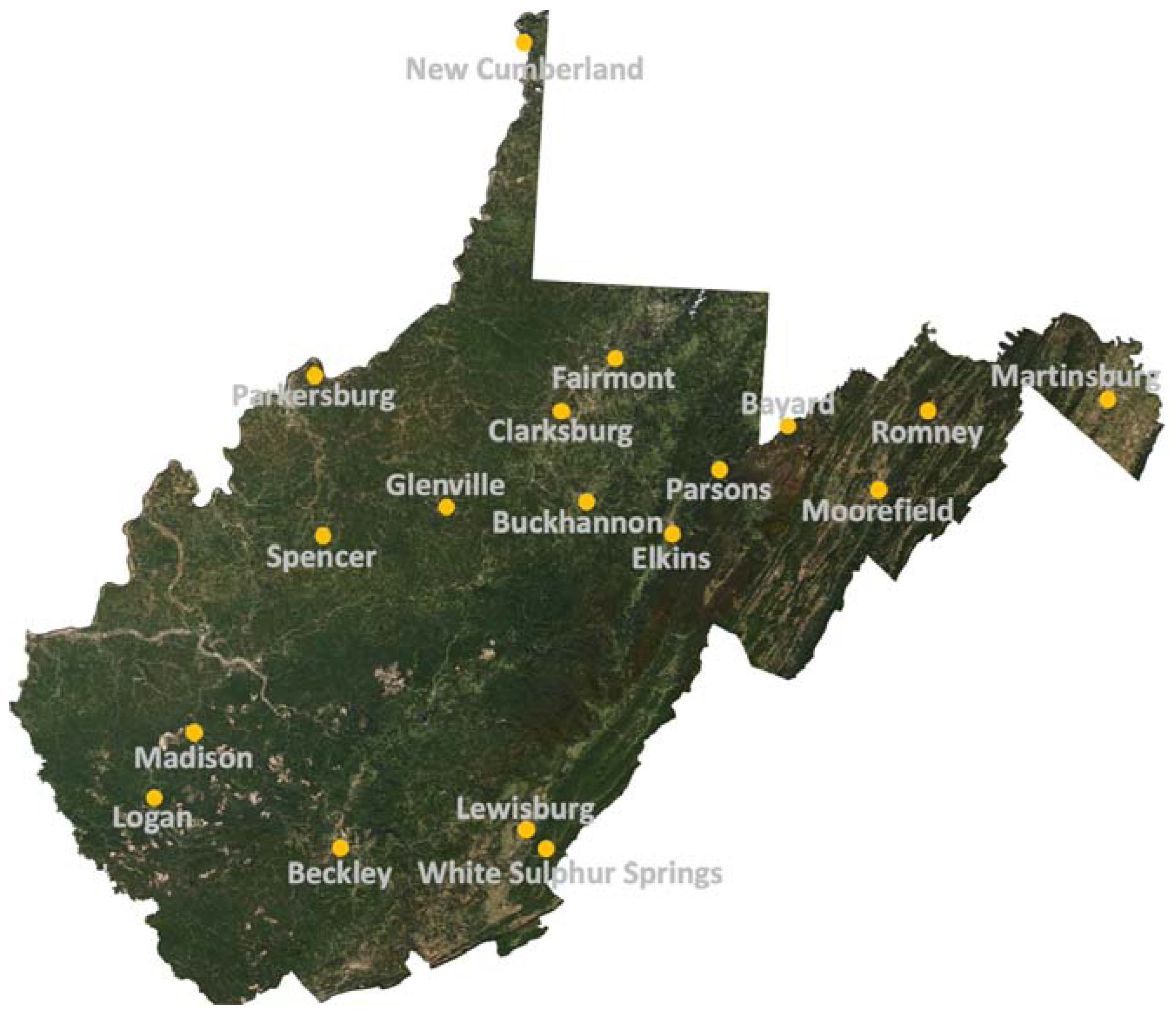
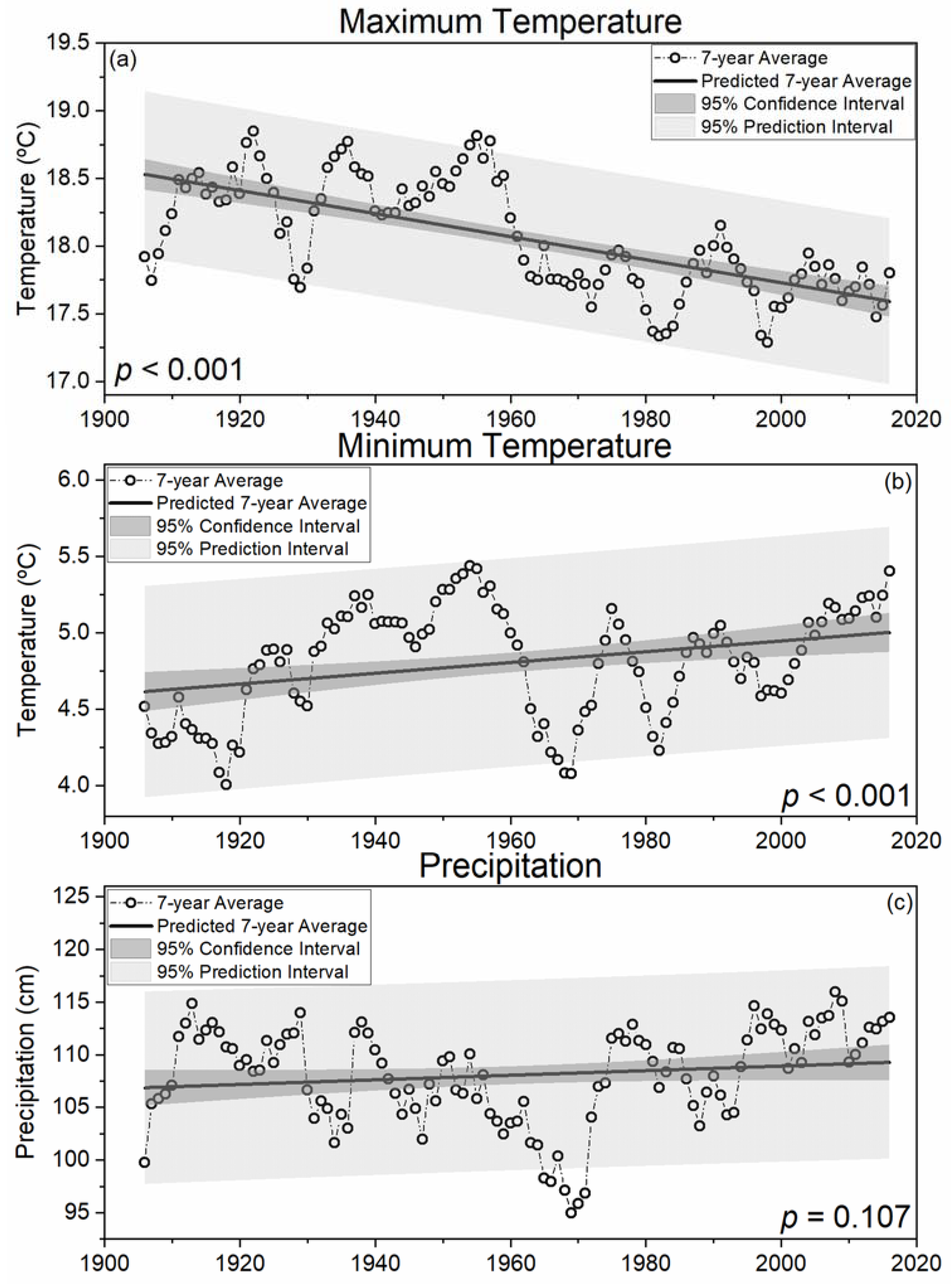
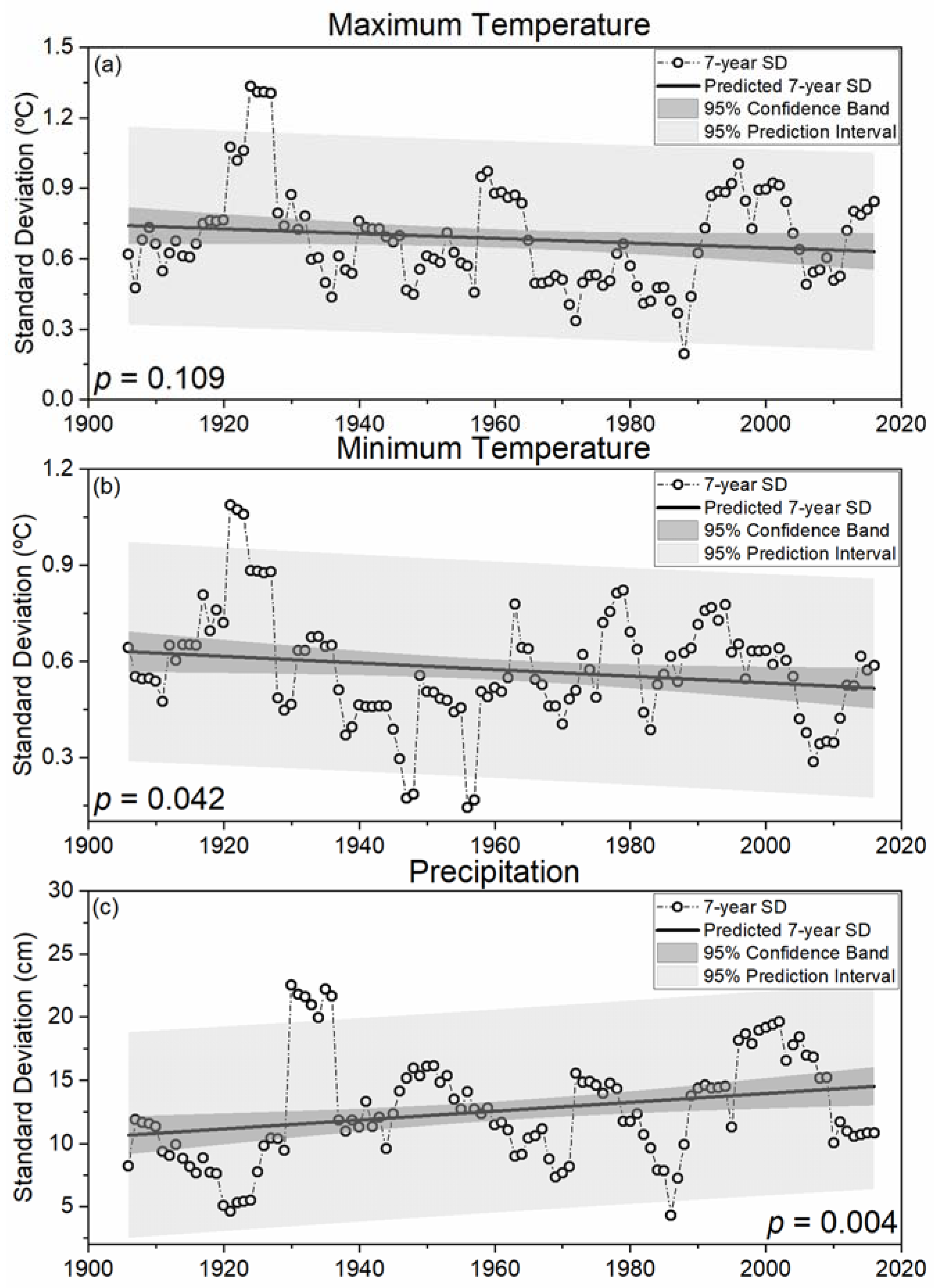
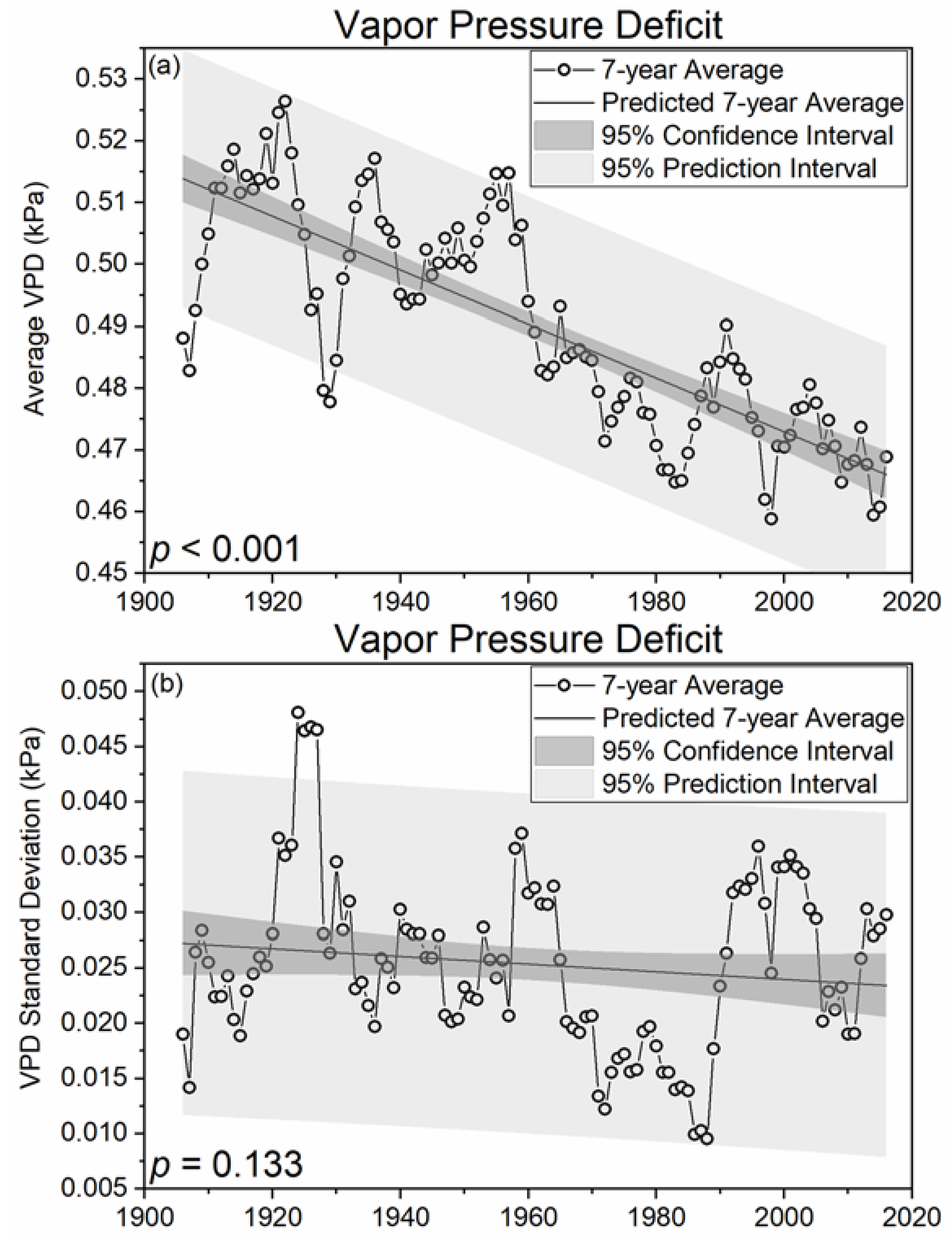
| Min | Median | Max | Mean | St Dev | Trend | ||
|---|---|---|---|---|---|---|---|
| 7-year Moving Average | Max | 17.3 | 18.0 | 18.8 | 18.1 | 0.4 | −0.085 * |
| Min | 4.0 | 4.9 | 5.4 | 4.8 | 0.4 | 0.035 * | |
| Precip. | 95.0 | 108.8 | 116.0 | 108.1 | 4.6 | 0.218 | |
| VPD | 0.459 | 0.486 | 0.526 | 0.490 | 0.017 | −4.35 × 10−4 * | |
| 7-year Moving St Dev | Max | 0.2 | 0.7 | 1.3 | 0.7 | 0.2 | −0.010 |
| Min | 0.1 | 0.6 | 1.1 | 0.6 | 0.2 | −0.010 * | |
| Precip. | 4.3 | 11.8 | 22.5 | 12.6 | 4.2 | 0.352 * | |
| VPD | 0.010 | 0.025 | 0.048 | 0.025 | 0.008 | −3.46 × 10−5 |
© 2018 by the authors. Licensee MDPI, Basel, Switzerland. This article is an open access article distributed under the terms and conditions of the Creative Commons Attribution (CC BY) license (http://creativecommons.org/licenses/by/4.0/).
Share and Cite
Kutta, E.; Hubbart, J.A. Changing Climatic Averages and Variance: Implications for Mesophication at the Eastern Edge of North America’s Eastern Deciduous Forest. Forests 2018, 9, 605. https://doi.org/10.3390/f9100605
Kutta E, Hubbart JA. Changing Climatic Averages and Variance: Implications for Mesophication at the Eastern Edge of North America’s Eastern Deciduous Forest. Forests. 2018; 9(10):605. https://doi.org/10.3390/f9100605
Chicago/Turabian StyleKutta, Evan, and Jason A. Hubbart. 2018. "Changing Climatic Averages and Variance: Implications for Mesophication at the Eastern Edge of North America’s Eastern Deciduous Forest" Forests 9, no. 10: 605. https://doi.org/10.3390/f9100605
APA StyleKutta, E., & Hubbart, J. A. (2018). Changing Climatic Averages and Variance: Implications for Mesophication at the Eastern Edge of North America’s Eastern Deciduous Forest. Forests, 9(10), 605. https://doi.org/10.3390/f9100605





